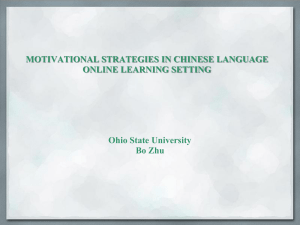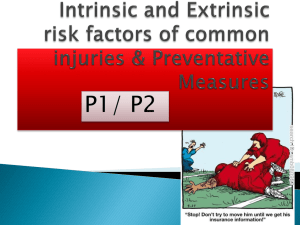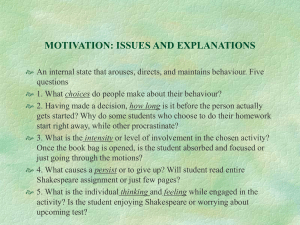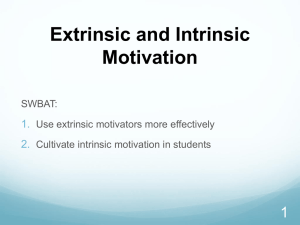An Investigation of the Causal
advertisement
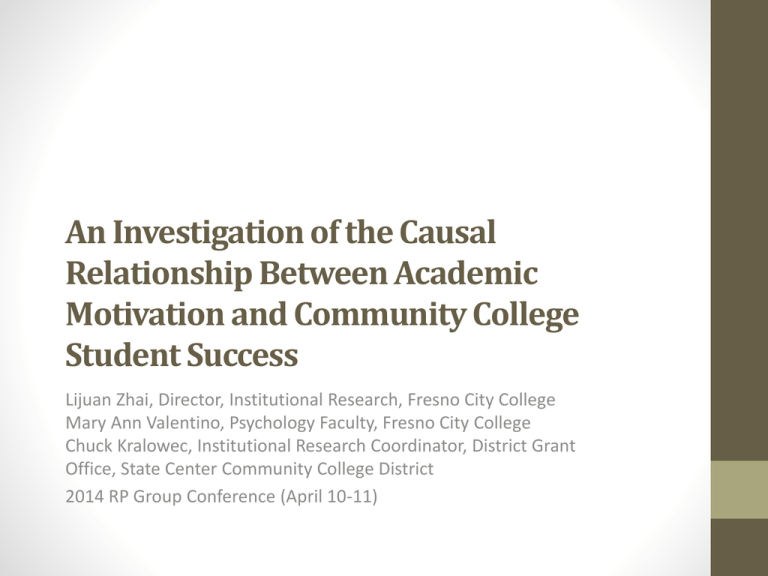
An Investigation of the Causal Relationship Between Academic Motivation and Community College Student Success Lijuan Zhai, Director, Institutional Research, Fresno City College Mary Ann Valentino, Psychology Faculty, Fresno City College Chuck Kralowec, Institutional Research Coordinator, District Grant Office, State Center Community College District 2014 RP Group Conference (April 10-11) Introduction • Psychology faculty investigating possible variables that influence success rates in general psychology class, which historically has success rates that are lower than the college and the division (social sciences). • Anecdotally, instructors often cite motivation or lack thereof as a reason for student success or failure. Introduction • We decided to find and use an instrument to investigate the correlation between success and motivation with our general psychology students. • If motivation, and specifically certain types of motivation, is associated with higher rates of success, would it be possible to design interventions, at the departmentand/or at the college-level to increase motivation? Introduction • Motivation is defined as “a process that arouses, maintains, and guides behavior toward a goal” (Cacioppo & Freberg, 2013) Cacioppo, J.T. & Freberg, L.A. (2013). Discovering Psychology: The Science of Mind. Canada: Wadsworth, Cengage Learning. Introduction • Formal education is an essential prerequisite of professional progress and it is vital to identify the psychological factors which determine academic achievement. • Recent research conducted in this field emphasizes the importance of difference motivational constructs. Introduction • Motivation is related to student learning and performance (Vallerand, Pelletier, Blais, Brière, Senécal, & Vallières, 1992). • In their recent article, Wagner & Szamoskozi (2012) conducted a meta-analysis on the effects of academic motivation and achievement training programs. They concluded that academic motivation has a great impact on academic performance (Wagner & Szamoskozi, 2012). It contributes to the prediction of school achievement above and beyond intelligence. Academic Motivation • Academic motivation has been defined in various ways: • “a student’s willingness, need, desire and compulsion to participate in, and be successful in the learning process” (Moenikia & Babelan, 2010, p. 1538). Academic Motivation • Several conceptual perspectives have been proposed in order to better understand academic motivation, including intrinsic motivation, extrinsic motivation, and amotivation (Vallerand, et al.,1992). These three types of motivations are defined as follows: • Intrinsic Motivation (IM) refers to the fact of doing an activity for itself, and the pleasure and satisfaction derived from participation (Deci, 1975; Deci & Ryan, 1985, as cited in Vallerand, et al.,1992) • Extrinsic Motivation (EM) pertains to a wide variety of behaviors which are engaged in as a means to an end and not for their own sake (Deci, 1975, cited in Vallerand, et al.,1992). Academic Motivation • Amotivation is neither intrinsic nor extrinsic. When amotivated individuals experience feelings of incompetence and expectancies of uncontrollability, they perceive their behaviors as caused by forces out of their own control. Eventually, they may stop participating in academic activities (Vallerand, et al.,1992). • Survey Instrument • To measure student motivation, Academic Motivation Scale (AMS) was used. AMS was developed and validated by a group of scholars in Canada (Vallerand, et al.,1992). The survey instrument was widely used and validated by many researchers. • Academic Motivation Scale (AMS) was developed based on the self-determination theory (SDT) proposed by Deci and Ryan (1985). • Deci and Ryan basically identify “several distinct types of motivation” (Ryan & Deci, 2000, p. 69). These types of motivation root in the perceived locus of causality, which can be internal, external or impersonal (see figure 1): Ryan & Deci (2000) Self Determination Theory Survey Instrument AMS contains 28 survey questions and addresses the following seven aspects of academic motivation: 1. Intrinsic motivation - to know (questions # 2, 9, 16, 23) Intrinsic motivation to know is defined as the fact of performing an activity for pleasure and the satisfaction that one experiences while learning, exploring, or trying to understand something new (Vallerand, et al.,1992).. Survey Instrument 2. Intrinsic motivation - toward accomplishment (questions # 6, 13, 20, 27) Intrinsic motivation toward accomplishments is defined as the fact of engaging in an activity for the pleasure and satisfaction experienced when one attempts to accomplish or create something (Vallerand, et al.,1992). 3. Intrinsic motivation - to experience stimulation (questions # 4, 11, 18, 25) Intrinsic motivation to experience stimulation is operative when someone engages in an activity in order to experience stimulating sensation (e.g., sensory pleasure, aesthetic experiences, as well as fund and excitement) derived from one’s engagement in the activity (Vallerand, et al.,1992). Survey Instrument 4. 5. Extrinsic motivation – identified (questions # 3, 10, 17, 24) To the extent that the behavior becomes valued and judged important for the individual, and especially that it is perceived as chosen by oneself, then the internalization of extrinsic motives become regulated through identification. The individual might say: ‘I study the night before exams because it is something important for me.” Extrinsic motivation – introjected (questions # 7, 14, 21, 28) Introjected means the individual begins to internalize the reasons for his or her actions. This form of internalization, while internal to the person, is not truly self-determined since it is limited to the internalization of past external contingencies. Thus the student might say: “I study the night before exams because that’s what good students are supposed to do.” (Vallerand, et al.,1992). Survey Instrument 6. Extrinsic motivation - external regulation (questions # 1, 8, 15, 22) External regulation refers to the behavior regulated through external means such as rewards and constraints (Vallerand, et al.,1992). For instance, a student might say: “I study the night before exams because my parents force me to.” 7. Amotivation (questions # 5, 12, 19, 26) Amotivation is either intrinsic nor extrinsic motivation. Individuals are amotivated when they do not perceive contingencies between outcomes and their own actions. When amotivated individuals experience feelings of incompetence and expectancies of uncontrollability, they perceive their behaviors as caused by forces out of their own control. Survey Instrument • AMS has been widely used to measure motivation in student populations and, based upon results, various methods have been posited to improve motivation in students. • This instrument has been applied to elementary, high school, and undergraduate college students, in a number of different languages. • A review of the literature has not uncovered previous research in which the AMS has been applied to community colleges. • A motivation study of community college students would provide useful information to community college educators, allowing them to understand the type and level of motivation of our students and to develop motivation interventions. Research Objective • The objectives of the current research are to understand student academic motivation in a community college and to investigate casual relationship between academic motivation and academic performance. Method Definitions • GPA = Grade Point Average • Includes letter grades only, no pass/fail • Includes unit credit calculations • SR% = Success Rate • No unit credit calculations • A, B, C, or Pass = 1 • D, F, or Fail = 0 • “Latent” refers to unobserved variables that remove error variance from their observed variables and can serve as errorfree IV’s in path models, as in the current study Method • Model 1 & 2 • Missing item replacement using regression • Multivariate outliers removed • Seven factor oblique used to predict GPA • Model 1 • Cumulative, career GPA as of Fall ’13 • Model 2 • Independent observations of term 1, mid-career, and last term success rate Before Analysis, Model 1 • Prior to analysis, subjects with missing questions from subscales 1 (n=27), 2 (n=54), 3 (n=51), or 7 (n=39) were dropped because independent t-tests showed that their scores differed significantly on other average subscale scores than subjects without missing items from those subscales. 103 subjects with missing items from one of the four subscales and were dropped, and 8 subjects without cumulative GPAs as of fall 2013 were dropped. • Regressions were performed to determine new scale scores for any missing items from predicting the average score on the missing subscale from the average scores on all the other subscales. Each new score was rounded to the nearest whole number. Afterwards, 680 subjects had no missing items, 12 had items missing on the first subscale, 24 had items missing from the 2nd, 12 had items missing from the 4th, 5 from the 5th, 5 from the 6th, and 2 were missing items from both the 2nd and 5th scales and were removed. All missing items were replaced with regression-obtained scores. 8 students with missing valid GPAs were also removed. Only 22 students had missing items replaced with regression-obtained answers. • 53 cases where identified through Mahalanobis distance as multivariate outliers with p < .001 and were subsequently removed. • The final sample size for the study is N = 640 after removing 164 participants. Measurement Model (CFA) Item 2 Item 9 Item 16 Item 23 Item 6 Item 13 Item 20 Item 27 Item 4 Item 11 Item 18 Item 25 Item 3 Item 10 Item 17 Item 24 Item 7 Item 14 Item 21 Item 28 Item 1 Item 8 Item 15 Item 22 Item 5 Item 12 Item 19 Item 26 Intrinsic To Know Intrinsic Accomplishment Intrinsic Stimulation Extrinsic Identified Extrinsic Introjected Extrinsic Regulation Amotivation Item 2 Item 9 Item 16 Item 23 Item 6 Item 13 Item 20 Item 27 Item 4 Item 11 Item 18 Item 25 Item 3 Item 10 Item 17 Item 24 Item 7 Item 14 Item 21 Item 28 Item 1 Item 8 Item 15 Item 22 Item 5 Item 12 Item 19 Item 26 Intrinsic To Know Structural Model (SEM) Intrinsic Accomplishment Intrinsic Stimulation Extrinsic Identified Extrinsic Introjected Extrinsic Regulation Amotivation Cum GPA as of fa2013 Model Fit Statistics 7 Oblique-Factor Measurement Model Structural Model Measure (N=640) Value Measure (N=640) Value Χ2 Χ2(329)=1325.81, p <.001 Χ2 Χ2(350)=1362.72, p <.001 Χ2baseline Χ2(378)=29315.93, p <.001 Χ2baseline Χ2(406)=2992.490, p <.001 Χ2/df 4.03 Χ2/df 3.89 RMSEA .069 [CI .065 - .073] RMSEA .067 [CI .063 - .071] CFI .966 CFI .966 TLI .960 TLI .960 model model Item 2 1.00 Item 9 .86 Item 16 .79 Item 23 .86 Intrinsic To Know (#1) -.938 (.338) .784 (.099) .87 Item 6 1.00 Item 13 .84 Item 20 .86 Item 27 .89 Intrinsic Accomplishment (#2) .69 2.102 (.847) .90 Item 7 1.00 Item 14 .82 Item 21 .85 Item 28 .91 Extrinsic Introjected (#5) -1.526 (.591) Cum GPA as of fa2013 Significant Predictors of GPA Factor B (Error) Intrinsic – Toward Accomplishment* 2.10 (.85) Extrinsic – Introjected* -1.53 (.59) Intrinsic – To Know** -0.94 (.34) Extrinsic – External Regulation 0.78 (.49) Extrinsic – Identified -.30 (.39) Intrinsic – To Experience Stimulation .13 (.19) Amotivation -.12 (.12) GPA* full model R2 = .22 (.10) GPA* only the three significant predictors R2 = .16 (.08) Before Analysis, Model 2 • The same students that were removed for missing data in model 1 were also absent for model 2. • 57 cases where identified through Mahalanobis distance with p < .001 as multivariate outliers on the motivation scale and were removed. • 8 cases did not have complete academic records and were removed. 71 more were removed because they only had two or fewer terms in their academic careers, and three were needed to detect a linear slope. • The final sample size for Model 2 is N = 566 after removing 229 participants. Model 2 Definitions • “Latent Intercept” • Y = A + b1X1 • As in regression, serves as the starting point for an equation that would explain academic success… • …But latent intercept removes error in academic performance caused by sick days, family problems, etc. • Latent intercept could be conceived of as actual (as opposed to simply observed) academic performance • “Latent Trajectory” • • • • Y = A + b1X1 Serves as beta term in regression… …but removes error between time periods And could be conceived of as actual academic trajectory Unconditional Means Model Note. All semester success rate observations are independent. Latent Intercept 1 1 1 1st Semester SR% Mid Career SR% Last Sem SR% .712 .700 .769 Unconditional Slope Model -.012 Latent Intercept (.788) Latent (Linear) Trajectory (-.041) 0 1 1 1 2 1 1st Semester SR% Mid Career SR% Last Sem SR% .591 .658 .471 Intercepts of time periods were set to 0 Confirmatory Latent Trajectory Model Fit Statistics Unconditional Means Model Unconditional Slope Model Measure (N=566) Value Measure (N=566) Value Χ2model Χ2(2)=20.407, p <.001 Χ2model Χ2(1)=0.013, p =.91 Χ2 Χ2(3)=132.094, p <.001 Χ2 Χ2(3)=132.094, p <.001 Χ2/df 10.20 Χ2/df 4.92 RMSEA .128 [CI .081 - .180] RMSEA .000 [CI .000 - 0.046] CFI .857 CFI 1.00 TLI .786 TLI 1.02 baseline baseline Χ2Δ Measure Value Χ2difference Χ2Δ (1)=20.394, p <.001 Conditional Slope Structural Model To Know Accomplish ment Stimulation Identified Introjected Latent Linear Trajectory Latent Intercept 1 1st Semester SR% Regulation 1 0 1 1 Mid Career SR% 2 Last Sem SR% Amotivation Conditional Slope Structural Model *p<.05 †p<.07 Note. Intercepts of SR% in parentheses. Accomplish ment† To Know* -.15 Stimulation Introjected † Identified .29 Regulation -.21 -.012 Linear Trajectory (-.041) Intercept (.788) 1 1 0 1 1 2 1st Semester SR% Mid Career SR% Last Sem SR% (0) (0) (0) .712 .677 .501 Amotivation Structural Latent Trajectory Model Fit Statistics Conditional Slope Structural Model Measure (N=566) Value Χ2model Χ2(400)=1210.9, p <.001 Χ2 Χ2(465)=26742.761, p <.001 baseline Χ2/df 3.04 RMSEA .060 [CI .056 - 0.064] CFI .969 TLI .964 Results • CFA showed that a slope along with an intercept was more of a valid model than just the intercept • This means that there is a latent academic performance and a (slightly negative) latent academic trajectory over the course of one’s academic career • Latent trajectory of acad career is assumed to be linear and in a downward direction from first semester, mid career semester, and last recorded semester • On top of this, a model of academic motivation predicting intercept and slope provided additional explanation of variance for beginning, mid-career, and end-career performance • The same three factors showed at least moderate significant prediction over and above intercept and slope of academic achievement Conclusions • “To know”, “Introjected”, and “Toward accomplishment” seem to be the most important three factors of motivation affecting academic performance • In both models, “To know” and “Introjected” were negative predictors • “Towards accomplishment” was a positive predictor • The other four factors did not seem to contribute significantly Implications Negative Predictor Intrinsic motivation - to know (questions # 2, 9, 16, 23) Intrinsic motivation to know is defined as the fact of performing an activity for pleasure and the satisfaction that one experiences while learning, exploring, or trying to understand something new (Vallerand, et al.,1992). Interested in the topic but not for testing well? Pedagogy change toward more active learning? Educational planning? Implication Negative Predictor Extrinsic motivation – introjected (questions # 7, 14, 21, 28) Introjected means the individual begins to internalize the reasons for his or her actions. This form of internalization, while internal to the person, is not truly self-determined since it is limited to the internalization of past external contingencies. Thus the student might say: “I study the night before exams because that’s what good students are supposed to do.” (Vallerand, et al.,1992). Engaging in activity/learning but not effective? Educational planning? Introjected ineffective study strategies? Outside pressure? Implication Positive Predictor Intrinsic motivation - toward accomplishment (questions # 6, 13, 20, 27) Intrinsic motivation toward accomplishments is defined as the fact of engaging in an activity for the pleasure and satisfaction experienced when one attempts to accomplish or create something (Vallerand, et al.,1992). Engagement? More focus on grades/accomplishment? Educational planning? Implication Motivation enhancement interventions: • Achievement motivation training program (AMT)- is to change the achievement motive, an unconscious and recurring preference for emotionally rewarding experiences related to improving one’s performance (Pang, 2010). During these interventions, the participants are taught to think, feel and behave like a person high in need for achievement. • Attributional retraining (AR) - a motivational treatment that helps students reframe what they think about success and failure, encouraging them to take responsibility for their academic outcomes (Haynes et al., 2009) • Multidimensional motivation and engagement intervention - is the motivation and engagement wheel, in which motivation is characterized in terms of four higher order groups: adaptive cognitions (self-efficacy, mastery orientation, valuing), adaptive behaviors (persistence, planning and task management), maladaptive cognitions (uncertain control, failure avoidance, anxiety) and maladaptive behaviors (self-handicapping and disengagement). (professional development for faculty) Limitations & Future Directions • Some sample bias: Same sample used in all models, but sample was smaller in LTM. • Latent intercepts and slopes are difficult to interpret in general. • Model will be re-ran again on completion. • Survey could be tested for invariance between completers and non-completers. • Replicate the study (post –SEPs)


